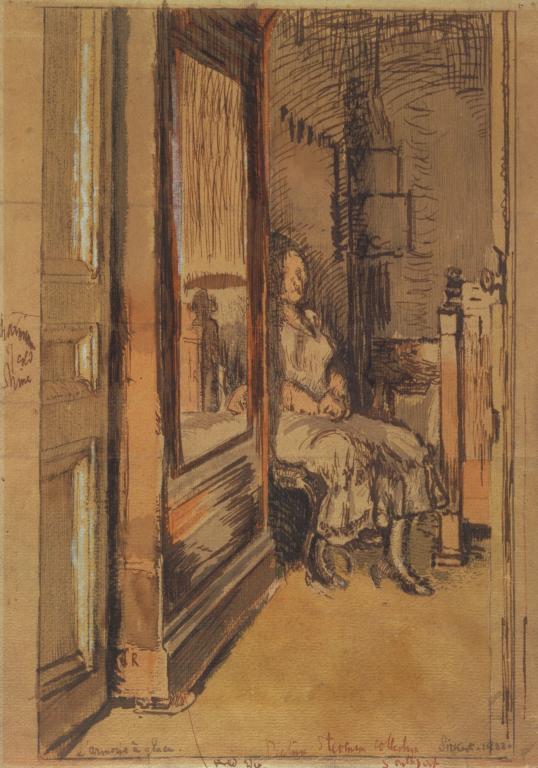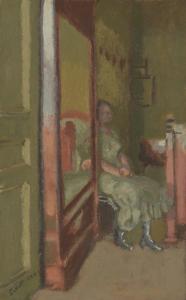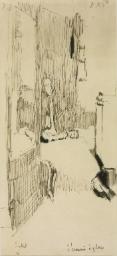Walter Richard Sickert Study for 'L'Armoire à glace' 1922
Walter Richard Sickert,
Study for 'L'Armoire à glace'
1922
This elaborate preparatory study in graphite overlaid with pen and ink, embellished with watercolour and white gouache highlights, includes marginal annotations describing the colour or light observed on particular surfaces. Walter Sickert made a number of studies of this scene, which looks through an open doorway onto a woman seated in the dark recesses of a bedroom, partially concealed by and partially reflected in a mirrored wardrobe. Sickert developed the picture into an etching as well as an oil of the same title (Tate N05313).
Walter Richard Sickert 1860–1942
Study for ‘L’Armoire à glace’
1922
Graphite, ink, watercolour and gouache on paper
268 x 191 mm
Inscribed by the artist ‘L’armoire à glace’ in grey paint bottom left; ‘red edge’ in black ink bottom centre; ‘Picture Stevenson [sic] collection Southport’ in red ink bottom centre; ‘Sickert. 1922.’ in grey paint bottom right; ‘... of cold shine’ in black ink centre left in margins.
Purchased (Knapping Fund) 1941
N05312
1922
Graphite, ink, watercolour and gouache on paper
268 x 191 mm
Inscribed by the artist ‘L’armoire à glace’ in grey paint bottom left; ‘red edge’ in black ink bottom centre; ‘Picture Stevenson [sic] collection Southport’ in red ink bottom centre; ‘Sickert. 1922.’ in grey paint bottom right; ‘... of cold shine’ in black ink centre left in margins.
Purchased (Knapping Fund) 1941
N05312
Ownership history
Walter Howarth, from whom purchased by Tate Gallery 1941.
Exhibition history
1926
An Exhibition of Drawings by W.R. Sickert A.R.A., Savile Gallery, London, February–March 1926 (44).
1942
The Tate Gallery’s Wartime Acquisitions, National Gallery, London, April–May 1942 (121).
1942–3
A Selection from the Tate Gallery’s Wartime Acquisitions, (Council for the Encouragement for Music and the Arts tour), Royal Exchange, London, July–August 1942, Cheltenham Art Gallery, September 1942, Ashmolean Museum, Oxford, October 1942, Galleries of Birmingham Society of Arts, November–December 1942, Fitzwilliam Museum, Cambridge, January–February 1943, Victoria Art Gallery, Bath, February–March 1943, National Museum of Wales, Cardiff, March–April 1943, Manchester City Art Gallery, April–May 1943, Philharmonic Hall, Liverpool, May–June 1943, National Gallery of Scotland, Edinburgh, June 1943, Glasgow Museum and Art Gallery, Kelvingrove, July 1943, Laing Art Gallery, Newcastle upon Tyne, August 1943 (83).
1944–5
Two Centuries of British Drawings from the Tate Gallery, (Council for the Encouragement of Music and the Arts tour), Bedford Public Library, September 1944, Lady Lever Gallery, Port Sunlight, September–October 1944, County Hall, Kendal, October 1944, Malvern Public Library, November 1944, Atkinson Art Gallery, Southport, January–February 1945, Graves Art Gallery, Sheffield, March–April 1945, Cathedral Refectory, Chester, April–May 1945, Harrogate Public Art Gallery, May–June 1945, Huddersfield Public Art Gallery, June–July 1945, Luton Public Museum, September 1945, Ferens Art Gallery, Hull, October–November 1945, Bristol City Museum and Art Gallery, November–December 1945 (65).
1957
Sickert: An Exhibition of Paintings, Drawings and Prints, Graves Art Gallery, Sheffield, August–September 1957 (149).
1971
Painting and Perception, MacRobert Centre Art Gallery, University of Stirling, October–November 1971 (28).
1998
Two British Impressionists: Walter Sickert and Philip Wilson Steer, Norwich Castle Museum, January–April 1998 (31, reproduced).
2004–5
Walter Sickert: ‘drawing is the thing’, Whitworth Art Gallery, Manchester, October–December 2004, Southampton City Art Gallery, January–March 2005, Ulster Museum, Belfast, April–June 2005 (3.13, reproduced).
References
1926
William Redworth, ‘Some Modern British Figure Drawings’, Studio, vol.91, May 1926, p.311, reproduced.
1960
Lillian Browse, Sickert, London 1960, p.103.
1964
Mary Chamot, Dennis Farr and Martin Butlin, Tate Gallery Catalogues: The Modern British Paintings, Drawings and Sculpture, vol.2, London 1964, pp.634–5.
1989
W.R. Sickert: Drawings and Paintings 1890–1942, exhibition catalogue, Tate Gallery, Liverpool 1989, p.32, reproduced.
2006
Wendy Baron, Sickert: Paintings and Drawings, New Haven and London 2006, no.557.1.
Technique and condition
This is a preparatory study for the painting L’Armoire à Glace (Tate N05313) in graphite, ink, gouache and watercolour on laid paper. It is a more elaborate study in comparison with the drawing of the same title in the Tate collection (Tate N06087). The artist has chosen a thin, fawn-coloured laid paper that is of good quality. The bottom edge is torn and the remainder are cut straight, suggesting that it was torn from a sketchbook. There are two horizontal creases that run parallel across the entire width of the sheet where it was once folded. The image is drawn within a rectangle outlined in graphite and there are narrow blank margins along the four edges of the sheet. There are several annotations in the margins that appear to relate to the appearance of particular elements of the drawing; ‘red edge’ indicating the near vertical edge of the wardrobe and ‘[illegible] of cold shine’ indicating the panels of the open door.
The work was begun in graphite, traces of which can still be seen, and then overlaid with pen and ink and embellished with watercolour washes and highlights in white gouache. The ink, which is perhaps iron gall ink, has faded to a warm brown colour and where it has been heavily applied has ‘burnt’ through to the verso of the paper. In some areas it has bled as a result of the subsequent application of watercolour. The paper, ink and watercolour have discoloured over time and the recto of the sheet now has a pinkish caste. There are several pinholes at the top corners and approximately ten found across the image. These may have been made by the artist pinning the work to a board or may relate to a transfer technique used to copy parts or the entire image to another support.
Tomoko Kawamura
November 2005
How to cite
Tomoko Kawamura, 'Technique and Condition', November 2005, in Nicola Moorby, ‘Study for ‘L’Armoire à glace’ 1922 by Walter Richard Sickert’, catalogue entry, April 2005, in Helena Bonett, Ysanne Holt, Jennifer Mundy (eds.), The Camden Town Group in Context, Tate Research Publication, May 2012, https://wwwEntry
In common with Ennui c.1914 (Tate N03846) and other earlier paintings of domestic interiors, the visual appearance of the oil painting L’Armoire à glace 1924 (Tate N05313, fig.1) developed across a series of related images. Walter Sickert first produced the subject as a 1922 etching of the same title,1 and a sequence of studies was also produced to facilitate the print.2 It is likely that Sickert referred to and in some cases reworked these drawings and watercolours for the oil version, completed in London. There are two preparatory sketches in Tate’s collection (Tate N05312 and N06087, fig.2).
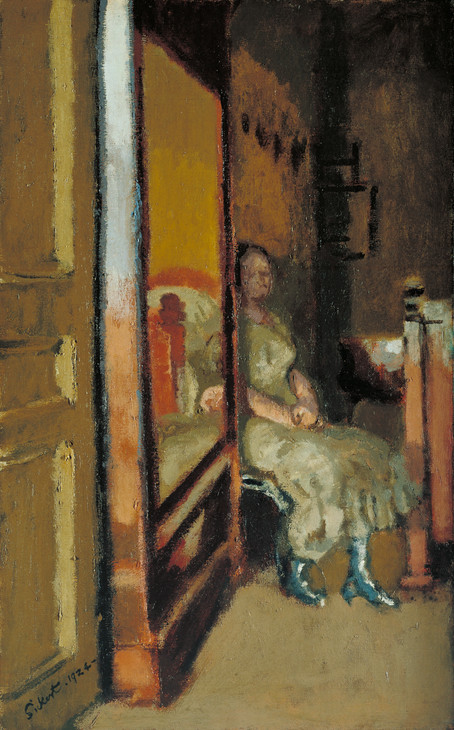
Walter Richard Sickert 1860–1942
L'Armoire à Glace 1924
Oil paint on canvas
support: 610 x 381 mm; frame: 745 x 517 x 83 mm
Tate N05313
Purchased 1941
© Tate
Fig.1
Walter Richard Sickert
L'Armoire à Glace 1924
Tate N05313
© Tate
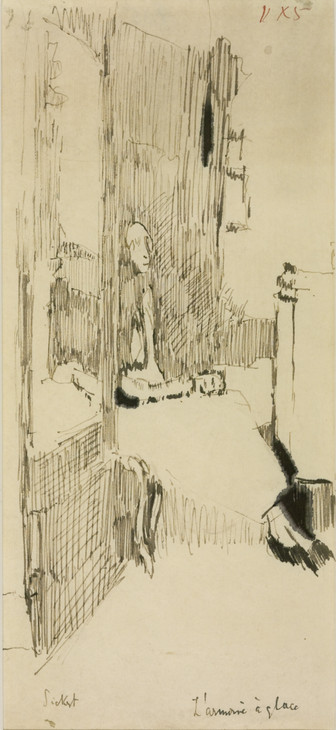
Walter Richard Sickert 1860–1942
Study for 'L'Armoire à Glace' c.1922
Ink on paper
support: 281 x 132 mm
Tate N06087
Presented by Roland, Browse and Delbanco 1952
© Tate
Fig.2
Walter Richard Sickert
Study for 'L'Armoire à Glace' c.1922
Tate N06087
© Tate
Study for ‘L’Armoire à glace’ is a full compositional colour study which has been first sketched lightly in pencil and then overlaid with pen and ink and washes of watercolour. There are also touches of white gouache in places, for example around the edge of the mirror and the reflected light on the panels of the door. In appearance it is closer to the etched version than the painting, because it includes the view of the edge of the bedroom door and doorknob on the far right of the picture. In addition, some of the drawn pen and ink lines are echoed within areas of line and cross-hatching in the etching. Furthermore, the receding perspective of the mirrored door is more oblique in the painting. Nevertheless, the fact that Sickert troubled to complete the study in watercolour suggests that he was always intending to paint a version in oil.
The work bears the inscription ‘Picture Stevenson [sic] collection Southport’, which refers to the first owner of the oil painting, William Henry Stephenson (see Tate N05313). Sickert presumably annotated the drawing at a later date, after Stephenson had purchased the oil version of the painting (which is signed and dated 1924). In size and appearance the work is very close to another study, Study for ‘L’Armoire à glace’ 1922 (pen and ink and wash on paper, private collection), which Sickert also gave to Stephenson. The author of the catalogue raisonné of Sickert’s prints, Ruth Bromberg, believes that this study formed the basis for an intermediate tracing which was then used to transfer the image to a copper plate etching. She suggests the pink watercolour wash was only added to the drawing after the etching was complete, possibly at the time when Sickert sent the work to Stephenson.3 By contrast, another compositional colour study, Mon Rêve: Study for ‘L’Armoire à glace’ 1922 (ink, watercolour and pencil, Museum of Fine Arts, Boston, inscribed ‘Moi depuis que j’ai mon armoire à glace je suis contente’ [Since I have had my mirrored wardrobe I am content]), exhibits similar use of watercolour wash but without the same level of detail added in pen and ink. Tate’s study is therefore the most complete and highly worked preparatory study for the painting.
Nicola Moorby
April 2005
Notes
Related biographies
Related catalogue entries
How to cite
Nicola Moorby, ‘Study for ‘L’Armoire à glace’ 1922 by Walter Richard Sickert’, catalogue entry, April 2005, in Helena Bonett, Ysanne Holt, Jennifer Mundy (eds.), The Camden Town Group in Context, Tate Research Publication, May 2012, https://www

